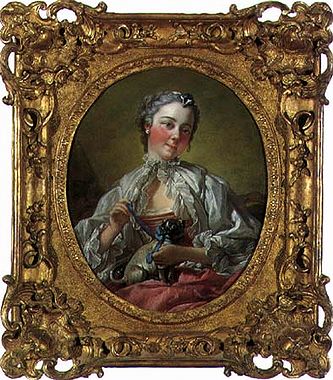Popis
François Boucher's "Portrait of Madame Boucher" (1745) is an eloquent example of the French painter's mastery of the art of portraiture during the Rococo period. Known for his ornate and sensual style, François Boucher captures in this painting not only the appearance of his model, but also an almost ethereal essence that combines intimacy with the sophistication of the 18th century setting.
In the composition, Madame Boucher's figure is positioned slightly to the left, allowing for a play of space that draws the viewer's attention. Her subtly relaxed posture suggests a character that blends dignity with intimacy, emulating a balance between the representation of an individual and a symbol of the fashion and culture of the moment. The lady is presented in a dress filled with soft folds, which flows delicately around her, and the meticulous attention to textual detail that Boucher manages to capture in the fabric is evident. The choice of fabric seems almost tangible, transporting the viewer into the world of luxury and sophistication of the French aristocracy of her time.
The colours of the work are particularly significant. Soft, warm tones dominate the palette, with shades of pink, cream and gold combining to create an optical effect of light reflecting off the woman’s skin, giving it an almost heavenly glow. Each brushstroke is carefully calculated, and the subtlety of colour reveals Boucher’s technical virtuosity. This focus on rich, luminous colourimetry is characteristic of the Rococo, where light and shadow play a fundamental role in building volume and creating a dreamy atmosphere.
The background of the painting, though less detailed than the central figure, provides an energetic yet calm base against which the figure of Madame Boucher is stated. The soft shades of green and blue in the background recall the idyllic landscapes and natural elements that were common in Rococo art, evoking a connection with nature and the everyday life of nobles. In this way, the portrait not only captures the figure, but also places her within a broader emotional and aesthetic context.
A fascinating aspect of the work is its reflection of Boucher's personal time, as he was a leading court portraitist and enjoyed a reputation as one of the most sought-after painters of his era. It is also notable that Madame Boucher, whose surname matches the artist's, was likely his first wife, adding a layer of intimacy and affection to the painting. This personal connection transforms the portrait into a testament not only to artistic virtuosity, but also to an intimate relationship between the artist and his subject.
Compared to other portraits of the same period, such as those of Jean-Marc Nattier, who often presented their sitters in more ceremonial poses, Boucher's style tends to be freer and more sensitive to the character of the individual. This work resonates with the essence of the Rococo philosophy itself, which advocated the expression of beauty and delicacy rather than the rigidity and formal movement of earlier periods.
"Portrait of Madame Boucher" is thus a genuine representation of the art of her time, a reflection of an intense personal relationship and an overwhelming stylistic skill that solidifies Boucher's position in the history of art. The delicacy of the figure, the mastery in the use of color and the formulation of an intimate space on the canvas are elements that invite the viewer not only to observe, but to feel the essence of what is represented and the depth of the human bonds that inhabit the work.
KUADROS ©, a famous painting on your wall.
Hand-made oil painting reproductions, with the quality of professional artists and the distinctive seal of KUADROS ©.
Painting reproduction service with satisfaction guarantee. If you are not completely satisfied with the replica of your painting, we will refund 100% of your money.

